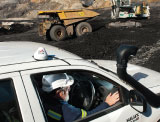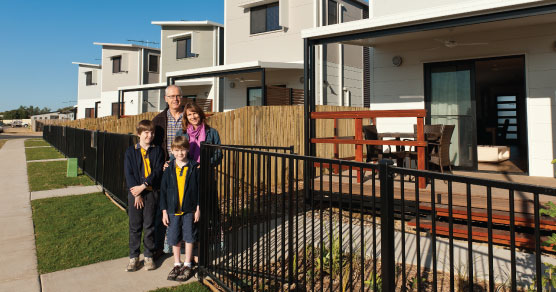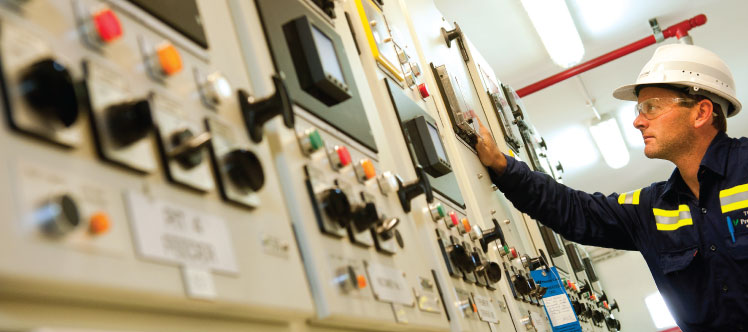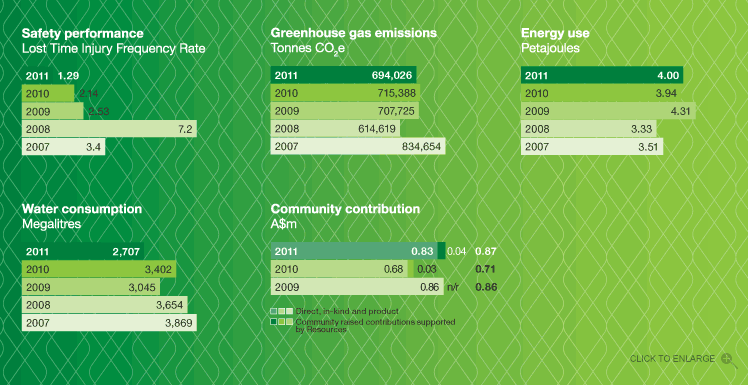Resources
Performance overview
Priorities and outcomes
-
Area 2010 Priority Outcome 
Safety To consolidate and improve upon our safety performance achieved in 2009/10  Not achieved
Not achievedDespite significantly reducing our LTIFR and Premier Coal going 463 days LTI-free, a fatality at Curragh resulted in an unacceptable safety performance for the year 
Environment Continue to improve greenhouse gas and energy measurement  Achieved
AchievedNew electricity meters were installed at Premier Coal and connected to Schneider ION Powering Monitoring Software, to allow the meters to feed data into its online monitoring and reporting SQL database 
Community Complete post handover agreement work around Lake Kepwari to assist Department of Environment and Conservation with public access to the lake  Not achieved
Not achievedPartial surrender of the lease and final handover of the lake has not yet occurred due to issues involving the State Agreement Act 
Environment Maintain accreditation to AS/NZS ISO 14001 Environmental Management System standard at Premier Coal  Achieved
AchievedTwo surveillance audits of the EMS were undertaken in December 2010 and May 2011, with both audits identifying that Premier Coal had established and maintained its management system in line with the requirements of the standard 
Environment Implement improvements to the waste management strategy at Curragh  Achieved
AchievedImprovements achieved through the provision of a total waste management contract with SITA Environmental Solutions. SITA provides total waste solutions through waste segregation, recycling and resource recovery 
Stakeholder engagement Complete agreement with Western Australian Government for establishment of the Shotts Industrial Park area  Partially achieved
Partially achievedSubstantial agreement has been reached between all parties on the development of an industrial park. Final issues are still being resolved with the State
Overview of the business
About our business
We are a significant Australian open-cut miner and a leading metallurgical coal producer and supplier of thermal coal for domestic power generation. We operate the Curragh open cut coal mine near Blackwater in Queensland's Bowen Basin, have a 40 per cent interest in the Bengalla mine in the Hunter Valley of New South Wales and, for the reporting period, operated the Premier Coal mine near Collie in Western Australia1. The Bengalla mine is not covered in this report as it is managed by Coal and Allied and is included in its public reporting.
At 30 June 2011 we had 809 people permanently employed: 43 at the Resources divisional office; 476 at the Curragh mine operation; and 290 at the Premier Coal operation. The combined coal production for Curragh and Premier Coal was 11.36 million tonnes which was 4.2 per cent lower than the previous year.
Year in review
This has been a challenging year on many fronts for our operations. While we have invested our time and resources into improving all aspects of our long-term sustainability, our performance outcomes in some areas were less than we had hoped for. This is particularly so this year in safety where, despite reducing our LTIFR by 40 per cent from 2.14 to 1.29 and achieving 463 days LTI free at our Premier Coal mine, sadly a contract worker was fatally injured in a single light vehicle incident at our Curragh mine in August 2010.
This is a reminder that we must continue to focus on preventing workplace incidents.
The central Queensland floods and record rainfall during the period September 2010 to May 2011 significantly affected operations at our Curragh mine. This has not only reduced production but challenged our ability to manage water and broader environmental issues on-site. The need for significant dewatering activities at Curragh has seen a large amount of energy required for non-mining related activities, resulting in an increase in our energy intensity and a corresponding increase in our greenhouse gas emissions.
Despite these setbacks, our performance in regard to our community support, our people and the environment has included many successes and highlights such as the introduction of an Indigenous Traineeship program at Curragh, completion of new energy efficient housing at Blackwater, the successful roll-out of SAFEmine (a collision avoidance system) and the completion of the water treatment plant at Premier Coal.
Material issues
The material issues facing the division are improving our safety performance and improving our energy efficiency, reducing greenhouse gas emissions and water usage.
People
The safety of our people remains our principal focus. This year, our aim was to consolidate and improve upon our safety performance achieved in 2009/10. While it was pleasing that we achieved a 40 per cent reduction in LTIFR from 2.14 to 1.29 and that Premier Coal achieved 463 days LTI-free, sadly a contract worker was fatally injured in a single light vehicle incident at our Curragh mine in August 2010. This is a reminder that we must continue to focus on preventing workplace incidents.
This year, Premier Coal successfully rolled out a new safety initiative in the SAFEmine collision avoidance system which has been installed and implemented on all mobile mining machinery and vehicles entering the mine operation, including contractor vehicles. Premier Coal is the first major site in Australia to roll-out the SAFEmine technology.
Our Aboriginal employment and engagement strategy continued to make progress with initiatives across all operations. This was highlighted by Curragh's Indigenous Traineeship program in partnership with The Salvation Army Employment Plus, state and local governments and contracting company, Thiess.
In a major step forward for the standard of living for our Curragh employees, the construction of 19 two-storey houses and 14 apartments has commenced in Blackwater.
Our commitment to attracting, engaging and retaining our people has seen the introduction of a division-wide employee survey to get feedback from our employees on what they think is important, how we are performing and what we can do better. This survey is now driving an action plan to enhance the working environment for our employees across all sites. Investing in the development of our people remains central to our approach. This year's focus on women in leadership, succession and development planning and employee engagement is key to achieving our goal of being a great place to work.
Environment
The major focus of our environmental efforts this year has been related to water. In Curragh's case it was the result of the record rainfall and floods and in Premier Coal's case the need to dewater pits prior to commencing mining operations.
In order to minimise the effect of the floods on the bio-diversity of its mining lease, Curragh initiated an awareness and action program to ensure the protection of flora and fauna on-site and in surrounding areas. This program resulted in a greater understanding by employees of the bio-diversity of the environment of the mine. In addition, weed eradication and feral animal reduction programs started. An animal survey, relocation and voluntary support of a research project on the endangered Bridled Nailtailed wallabies at the nearby Taunton National Park also commenced.
At Premier Coal, an $8 million water treatment plant was completed in October 2010 to support the dewatering of future mining areas. The plant is designed to treat up to 70 megalitres of water per day with the clean water discharged into the east branch of the Collie River.
Carbon and energy
The management of greenhouse gas emissions and energy use remains one of the most challenging areas for our business. Improved measuring capability such as the introduction of new electricity meters at the Premier Coal mine and the further refinement of WESGERS is assisting our various operations to better understand their emission profiles and energy use. While progress has been made in this area, the record rainfall and floods in central Queensland have seen Curragh undertake a very significant dewatering program. This has resulted in additional energy being used for non-mining operations which has reduced our energy efficiency and increased our greenhouse gas emissions at that site.
Greenhouse emissions
Our total direct (Scope 1 and 2) greenhouse gas emissions were estimated to be 649,374 tonnes of CO2e, down 3.43 per cent on last year.
This equates to 4.04 kilograms of CO2e per Bank Cubic Metre (BCM), down 2.2 per cent on last year. The greenhouse gas emissions were largely due to fugitive emissions of 38 per cent, electricity 29 per cent and diesel 33 per cent.
Energy use
Our main energy use during the year related primarily to the operation of our draglines and coal handling and preparation plant at Curragh and diesel-operated equipment across the business. Total energy consumption was estimated to be 4.00 petajoules, up 1.52 per cent on last year. Our total energy consumption per BCM was estimated to be 24.93 megajoules, up 3.1 per cent on last year. This energy use is broken down into fuel of 80 per cent of total energy consumption and electricity 19 per cent with other sources such as explosives accounting for the remaining one per cent.
Governance
There were no environmental infringement notices or fines issued to either Curragh or Premier Coal. During the year, Premier Coal had two non-compliances. One of these events was due to a monthly water sample from a licence point not being taken while the other was for blast noise exceeding the Environmental Protection (Noise) Regulations. To date the Department of Environment and Conservation has not advised Premier Coal that any further action will be taken on these non-compliances.
Community
When central Queensland was devastated by floods during the reporting period, our employees at Curragh contributed to the emergency response by assisting with the movement of people via chartered coaches and aircraft, as well as moving supplies in the local area to where they were most needed. While this in-kind support was well-received, the impact of the floods ensured a major rebuilding effort was required, and the division and its employees made significant financial donations.
In June 2011, the Ngalang Boodja Mine Lake Aquaculture Project achieved a major milestone with the first commercial harvest of marron and the opening of Collie Valley Marron.
The Brisbane office, Curragh and Premier Coal operations continue to make substantial contributions to their communities, supporting local health services, education, the arts, Aboriginal employment opportunities and local tourism initiatives.

The SAFEmine system in operation at Premier Coal, at Collie, Western Australia.
1. In September 2011, Wesfarmers announced the sale of Premier Coal for $296.8 million.



Housing for the 21st Century
Since it commenced operations in 1983, Curragh has always been synonymous with quality housing for its employees. Curragh established a new benchmark in the provision of housing purpose-built for the mining industry, a standard which it has proudly maintained since those early years.
However, with an expanding workforce this year, Curragh announced a new housing development for employees and their families in Blackwater. Construction commenced in March 2011 of 19 two-storey houses and 14 apartments. With quality family and single accommodation in scarce supply this housing project is a very welcome addition to the Blackwater community.
The design and construction was undertaken by Panorama Property Group Pty Ltd, a central Queensland property development and construction company.
The housing project uses modular technology, with individual modules constructed off-site and delivered to the location complete with fixtures and fittings.
This method of construction is highly sustainable; off-site constructions, or buildings constructed within a factory environment, have the potential to reduce waste by up to 30 per cent.
Significantly, further environmental benefits are realised through energy and water efficient construction, noise limitation and dramatically reduced vehicle movements during construction.
Climate responsive elements were incorporated into the building design, resulting in an average rating of 6.1 Stars issued by Sustainability House. The high thermal energy efficiency rating significantly reduces the requirement for heating and cooling to maintain a comfortable environment. There has been an emphasis placed on functional floor plans and the use of space within each residence. Large bedrooms, each supplied with individual ensuites, will cater to the unique accommodation requirements of mining communities. Privacy will be maintained with screening and landscaping designed to complement the local climate but support an indoor/outdoor lifestyle.
Landscaping will be an important feature of the development, using plants native to the area such as Tuckeroos. These quick growing trees will feature throughout the development, maintaining a cool outdoor space for most of the houses and the apartment grounds.
The project is being undertaken in a way that supports local businesses and jobs, as well as ensuring the needs of the workers and their families are met, that the buildings are energy efficient and that waste minimisation is a focus throughout construction.
Since it commenced operations in 1983, Curragh has always been synonymous with quality housing for its employees.
Left: New housing for Curragh employees at Blackwater, Queensland.


